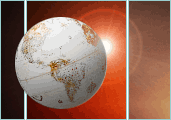Winter Solstice for Kids

Dec. 21, 2016, 5:44 A.M. EDT (10:44 UT*)), marks the solstice—the beginning of winter in the Northern Hemisphere and summer in the Southern Hemisphere
 Related Links |
Did you ever wonder why the days are so long in the summer and so short in the winter? The length changes throughout the year. In the summer, around June 21 or 22, we experience the summer solstice, which is the longest day of the year. And in the winter, December 21 or 22 is the winter solstice, or shortest day.
But wait! If you live in Australia, you experience the opposite—the longest day is in December and the shortest is in June. Why?
Earth's Angle
The answer all depends on Earth's tilt. In the course of one year, Earth orbits around the sun. It does not complete this trip, however, with the North Pole at the top and the South Pole at the bottom because Earth is tilted. In fact, it's tilted just about 23.5º. So at different times of the year, either the northern or the southern hemisphere is tilted toward and is therefore closer to the sun.
So if you live in the northern hemisphere (north of the equator), Earth is tilted toward the sun in the summer and away from the sun in the winter. The solstice marks the turning point, when the days begin to grow longer (in the winter) or when they begin to grow shorter (in the summer). At the solstice itself, however, the sun appears to stand still in the sky for a few days before and after. The word solstice, in fact, comes from the Latin for sun + to stand still.
Reasons for Seasons
But then why, if the solstice is the turning point, is June 21st considered the first day of summer and December 21st the first day of winter? This odd fact is because while the hours of daylight are changing, the oceans need to catch up. Oceans take a long time to heat up and cool down (something called thermal inertia). In June, they are still cool from the winter, so the warmest days happen in July and August. (Have you ever gone swimming off Cape Cod in June? Brrrr!) Similarly, the oceans hold onto the warmth of summer long after the barbeques have ended. So the coldest days usually happen in January and February. (Again, everything is reversed if you live below the equator.)
Even stranger, Earth is closest to the sun between January 3 and 5, but since the northern hemisphere is tilted away from the sun, the nights are long and the weather is cold.
Celebrating the Solstice
People from many different cultures have held solstice celebrations for thousands of years. For our distant ancestors, dependent on hunting, gathering, and growing, the seasons and the weather played a central role in their lives.
In the northern hemisphere, passing the winter solstice meant the return of the sun, which seemed to be disappearing. Many religious and cultural traditions celebrated the rebirth of sunlight after this dark period. The summer solstice, on the other hand, was a time to celebrate renewal, life, fertility, and the potential for a good harvest. It was celebrated through outdoor feasts with singing, dancing, and bonfires.
Winter Traditions
No one knows for sure when Jesus was born. Selecting December 25th to celebrate Christmas was probably no accident. Non-Christians celebrated the rebirth of the sun at this time, traditionally a male god or celestial ruler. Romans celebrated Saturnalia, honoring their god Saturn, with a weeklong December feast beginning December 14th and including observance of the solstice. Homage was also paid to Mithra, an ancient Persian god of light. Similar examples come from numerous cultural and religious traditions. Some scholars believe that Christians chose to celebrate Christ's birth on December 25th to make it easier to attract pagans to their faith.

Many seasonal symbols that today are connected to Christmas have their roots in the solstice and pagan celebrations. For example, the yule log came from a pagan ritual. The log was lit on the eve of the solstice—to conquer the darkness, protect against evil spirits, and bring luck—and burned for 12 hours. The log was later replaced by a tree, adorned with burning candles (don't try that at home!).
The Celts thought the sun stood still for 12 days in the middle of winter (could that be the source of the 12 days of Christmas?). Holly, with its bright berries and rich foliage, was an important symbol because it could withstand the harshness of winter and maintain its color and life, as could mistletoe and evergreens.
Building on the Solstice
Ancient buildings have long reflected people's fascination with the sun. Stonehenge is perhaps the best known of these stone structures. Another prehistoric stone building, in Newgrange, Ireland, and dating from about 3,300 BCE, allows sunlight to penetrate to the back of the cairn only at sunrise on the winter solstice. The neolithic cairn at Maeshowe on the Orkney Islands lets in the setting sun on the same day. And the Bighorn Medicine Wheel in Wyoming, one of 40 or more similar "wheels" found in the Rocky Mountains, serves a similar astronomical function.
